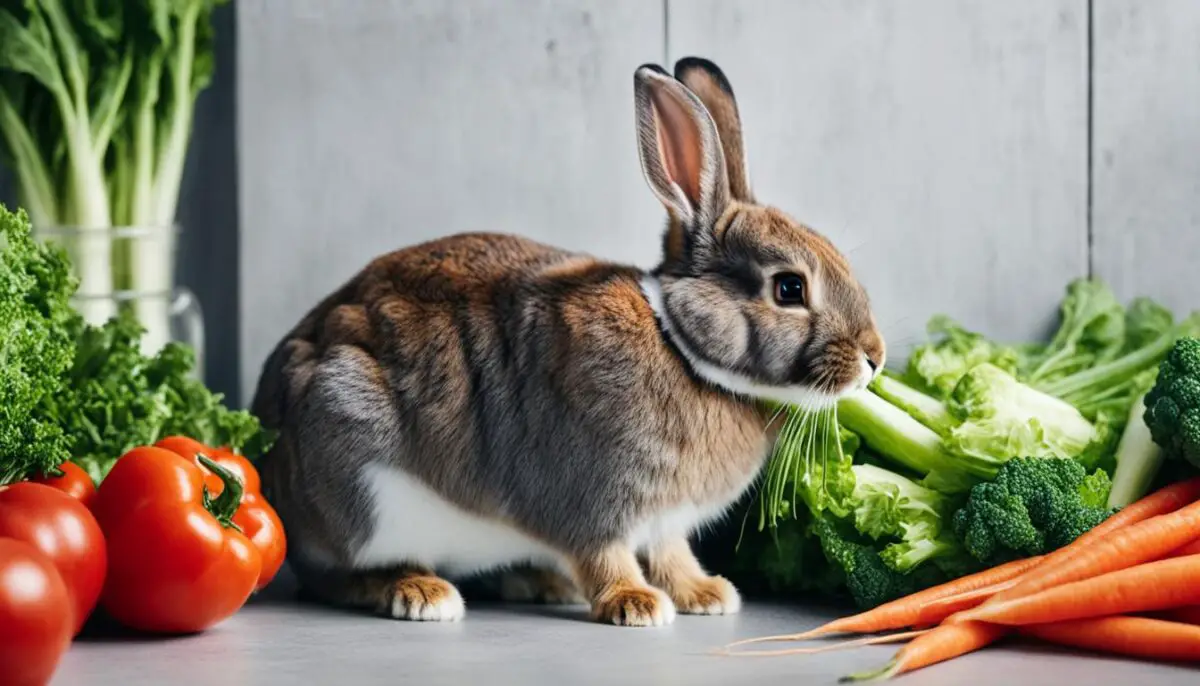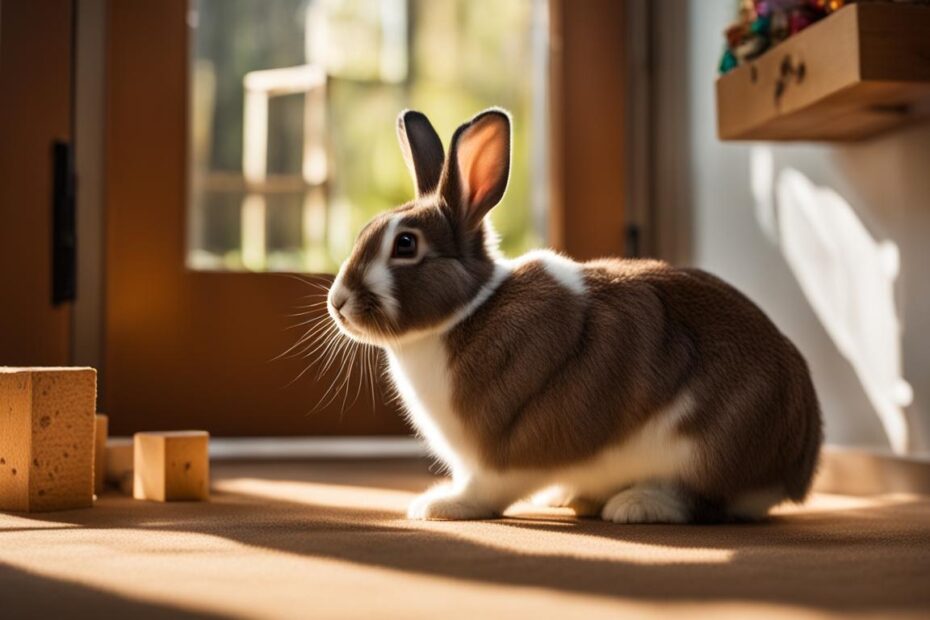Can you bring an outdoor rabbit inside to play? Many rabbit owners wonder about the benefits and safety considerations of bringing their outdoor rabbits indoors. While The Bunny Lady advocates for keeping rabbits as indoor pets, supervised outdoor time can provide valuable mental stimulation, exercise, access to grass, and sunlight. In this article, we will explore the steps you can take to ensure a happy bunny when bringing them inside to play.
Key Takeaways
- Supervised outdoor playtime for rabbits can offer mental stimulation, exercise, and access to grass and sunlight.
- Safety precautions should be taken, such as providing a rabbit run, to ensure the well-being of your outdoor bunny.
- Rabbits with health issues or vulnerabilities should stay indoors.
- The temperature for outdoor playtime should be between 50º to 75ºF.
- Consult with a veterinarian for personalized care advice and guidance.
Setting Up a Safe Outdoor Space for Your Rabbit
When it comes to caring for your rabbit, providing a safe outdoor space for them to play is essential. Not only does it give them a chance to explore and exercise, but it also provides mental stimulation and exposure to grass and sunlight, which are beneficial to their overall well-being.

| Dietary Component | Importance |
|---|---|
| Grass-Based Hay (Timothy Hay) | Provides fiber, aids digestion, and promotes dental health. |
| Leafy Greens | Offers essential vitamins and minerals for overall health. |
| Pellets | Supplemental feed for concentrated nutrition. |
| Treats | Occasional rewards that contribute to overall well-being. |
Understanding Your Rabbit’s Body Language and Needs
To ensure your rabbit’s happiness, it’s important to understand their body language and needs. By recognizing their cues and providing for their well-being, you can create a harmonious bond with your furry friend.
Signs of Happiness in Rabbits
Rabbits have their unique ways of expressing joy. When they’re happy, you may observe behaviors such as:
- Binkies – joyful hops and twists in the air
- Zooming – sudden bursts of energy, running and leaping around
- Flopping – relaxed stretches where they lie flat on their side
- Sprawling – lounging with their legs extended
- Purring – soft, contented sounds similar to a cat
- Tossing toys – playing and throwing objects in a playful manner
When you witness these body language signals, it’s an indication that your rabbit is feeling happy and at ease in their environment.
Providing a Comfortable Home Base
A comfortable home base is crucial for your rabbit’s well-being. Create a cozy and enriching environment by:
- Offering hideaways and tunnels for privacy
- Providing plenty of chew toys and interactive toys to keep them mentally stimulated
- Ensuring a spacious living area where they can hop around and explore
By giving your rabbit a secure and engaging space, you contribute to their overall happiness and mental stimulation.
Respecting Boundaries and Dislikes
It’s important to respect your rabbit’s boundaries and preferences. While some rabbits enjoy being held and cuddled, many prefer to have their own personal space. Respect their individuality and allow them to come to you for attention and affection.
“Remember, rabbits have unique personalities just like humans. Some may enjoy close interactions, while others prefer their independence. Always observe their body language to understand their comfort level.”
– Dr. Claire Austin, Rabbit Care Expert
Spaying or Neutering Your Rabbit
Getting your rabbit spayed or neutered can have significant benefits for their behavior and overall contentment. It can help reduce aggression, territorial marking, and certain health issues. Consult with a veterinarian to discuss the appropriate timing and procedure for your rabbit.
Summary
Understanding your rabbit’s body language and needs plays a vital role in their happiness and well-being. By recognizing signs of happiness, providing a comfortable home base, respecting their boundaries, and considering spaying/neutering, you can foster a loving and fulfilling relationship with your bunny companion.
Conclusion
Bringing an outdoor rabbit inside to play can greatly enhance their overall happiness and well-being. By creating a safe outdoor space and gradually transitioning them to an indoor environment, you can provide your rabbit with essential mental stimulation, exercise, and opportunities for bonding.
To ensure your rabbit’s happiness, it’s crucial to provide them with a comfortable home base. This includes a spacious enclosure that mimics their natural habitat, along with a variety of engaging toys and hiding places for mental enrichment. Understanding your rabbit’s body language and needs is also key to their contentment.
Indoor activities play a vital role in keeping your rabbit stimulated and entertained. Offering a range of toys, from chew toys to treat puzzles, can engage their minds and satisfy their natural instincts. Gentle interaction, such as petting and grooming, can help strengthen the bond between you and your rabbit. Additionally, supervised free-roaming time in a rabbit-proofed space allows for exploration and exercise.
Providing a healthy diet is essential for your indoor rabbit’s well-being. Grass-based hay, such as timothy hay, should make up the majority of their diet. Leafy greens and a small amount of pellets can also be included for dietary diversity. By prioritizing a balanced, hay-based diet and avoiding overindulgence in sugary treats, you can support their digestion and overall health.
In conclusion, by bringing your outdoor rabbit inside to play, you are providing them with numerous benefits for their physical and mental well-being. Creating a safe environment, engaging in indoor activities, maintaining a healthy diet, and understanding their communication cues all contribute to a happy and contented rabbit. Remember to prioritize their safety, supervise their playtime, and consult with a veterinarian for personalized care advice.
FAQ
Can I bring my outdoor rabbit inside to play?
Yes, you can bring your outdoor rabbit inside to play. It’s important to create a safe and stimulating indoor environment for them.
How do I set up a safe outdoor space for my rabbit?
To set up a safe outdoor space for your rabbit, you can use a rabbit run or a pet playpen. Ensure it is supervised, protected from predators, and free from toxic plants.
How do I transition my outdoor rabbit to an indoor environment?
Gradually introduce your outdoor rabbit to the indoor environment, allowing them to explore and adjust at their own pace. Provide a safe and predator-free indoor space for them.
What activities can I do indoors with my rabbit?
You can provide toys, such as chew toys and treat puzzles, to stimulate their minds. Cardboard tubes, tunnels, and balls can also provide additional enrichment. Gentle interaction, such as petting and grooming, is beneficial for bonding.
What should I feed my indoor rabbit?
A healthy diet for your indoor rabbit should consist of grass-based hay, such as timothy hay. Include leafy greens and a small amount of pellets. Avoid overindulging in sugary treats and prioritize a balanced, hay-based diet.
How can I understand my rabbit’s body language and needs?
Observing their behavior, such as binkies, zooming, and flopping, can indicate their happiness. Providing a comfortable home base enriched with toys and hiding places promotes their well-being. Respect their boundaries, including their dislike of being held.
What are the benefits of bringing an outdoor rabbit inside to play?
Bringing your outdoor rabbit inside to play provides mental stimulation, exercise, and bonding opportunities. It allows them to adjust to a safe indoor environment and promotes their overall happiness and well-being.


